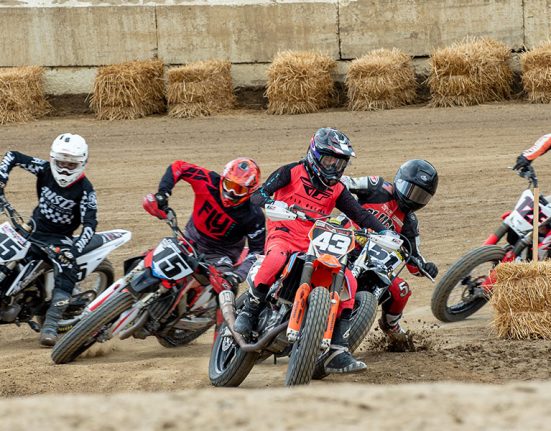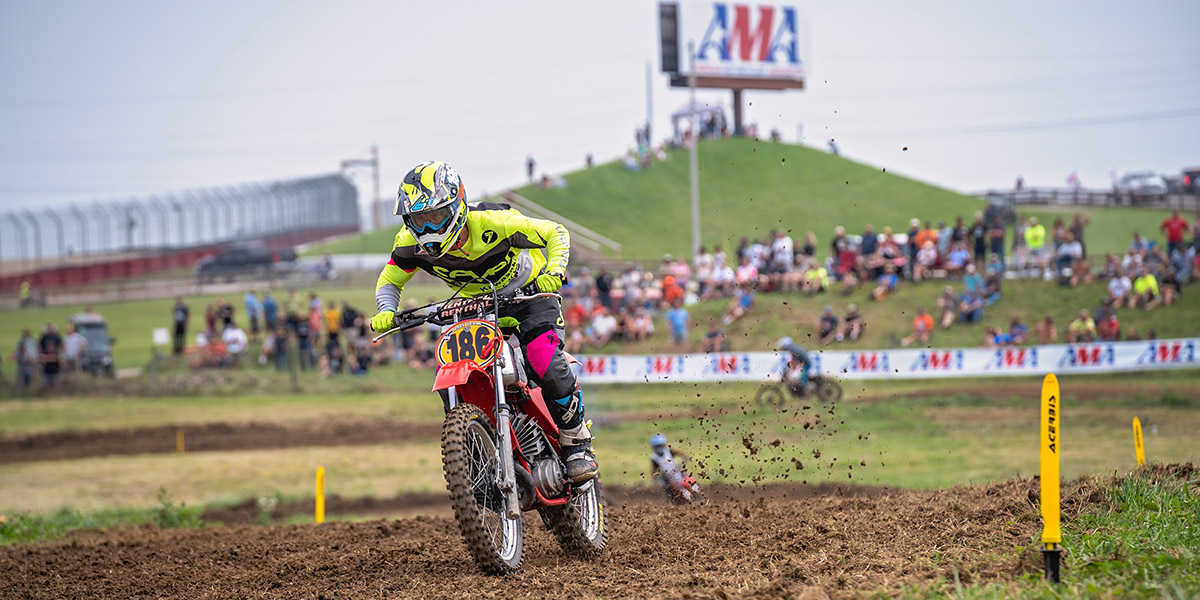Getting Started Racing Motocross
Motocross is probably the most-accessible form of racing to pick up.
The easy availability of inexpensive and reliable race bikes, the large number of riding and racing facilities, and a super-supportive racing community all make motocross the best way to dip your toe into the racing world. Here’s everything you need to know to get started down the right path:
Finding a Dealer and buying a bike
Whether you already own a bike or plan on buying a new/used bike, it helps to find a dealer for parts and service as well as additional advice on getting started.
It’s important to purchase the correct machine for AMA racing class that you plan to participate in. AMA racing classes are specifically designed by the AMA racing congress to match the age of the rider to a particular engine displacement category. Youth classes are designated by age and machine size (measured in cc’s). Adult classes (125cc and up) are either formed by machine size and age, or rider classification/experience.
If purchasing a bike, use this guide to help pick out the correct machine for AMA Racing.
- Ages: 4 to 6: 50cc 2-stroke/4-stroke. Max Front Wheel of 10”
- Ages: 7 to 8: 50cc 2-stroke. Max Front Wheel of 12”
- Ages: 7 to 11: 65cc 2-stroke
- Ages: 9 to 15: 85cc 2-stroke
- Ages: 12 to 16: 112cc 2-stroke or 150cc 4-stroke. Max Front Wheel of 19”
- Ages: 12 & Above: 125cc 2-stroke
- Ages: 14 & Above: 201cc 2-stroke – 350cc 2-stroke/4-stroke
- Ages: 16 & Above: 351cc – Open cc 2-stroke/4-stroke
Safety Gear
There is a simple rule in motorsport racing: don’t dress for the ride, dress for the crash.
Crashes happen, especially in racing. The more and the better the safety gear, the more likely you are to get up and walk away from an accident, instead of taking an ambulance ride. Motorcycle safety gear technology has expanded by leaps and bounds over the past decade, allowing racers to feel more comfortable, ride faster, and have more fun all while being protected better than ever before.
Amateur riders — especially young beginning riders — should be more concerned with wearing as much protection as possible than with looking like their favorite pro racer. Buying safety gear is something a good dealer can really help with. It’s extremely important to get sized correctly for motocross safety gear.
- Helmet: This is the single most important piece of protection you will buy. It is mandatory for all participants taking part in practice and competition to wear a full-face protective helmet in AMA-sanctioned events. The helmet must be properly fastened, fit well, and be in good condition. The helmet must have a chin strap retention system, and that chin strap must be fastened snugly so that the helmet will not come off in the event of a crash. The helmet needs to conform to either the recognized standards of Snell M2010 or DOT. A certification sticker should be visible on the back of the helmet.
- Goggles: These should always be worn while on a bike. It’s critical to protect your face and eyes from roost and other debris at all times. Make sure the lenses are shatterproof. Try on different brands while wearing your helmet to find the best and most comfortable fit (flush to your face). Using a tear-off system is a great way to clear your vision while on the track during the race.
- Body Armor: This is also known as the chest, back, or roost protectors. Body armor can help protect your core from an impact injury by spreading the force of the impact over a wider area. It also protects you from roost (hard clods or small rocks thrown up from tires). There is a huge variety available in different colors in both body armor (front and back) and chest-only protectors.
- Clothing: Long-sleeve jerseys and protective pants made from a durable material and are required to race motocross. You are further recommended to buy some sort of knee pad or knee braces. Kneepads or knee braces are designed to fit under your gear. Gloves are also recommended. Elbow pads are optional, but also a good idea especially for beginners.
- Boots: To race AMA events, boots with a protective toe shield must be at least 8 inches high, and a combination of buckles and/or laces to provide secure attachment. When you buy motocross boots, take the time to break them in properly until they are comfortable. Racing with boots that are not properly broken in can restrict movement and restrict your ability to use the foot controls. If you are buying for your child, buy them a little big—but not too big—to allow for growth. Motocross boots can take a pounding. Cleaning and maintaining your boots can help them last many seasons.
Just for Parents
Motocross racing is a great sport for kids. It teaches discipline, maturity, the importance of preparation, goal setting and delivers the satisfaction that can only come from reaching your goals — as well as dealing with the disappointment of working hard but coming up short. Unlike team sports like baseball, football and soccer, motocross is an individual sport. This can be helpful in teaching young people personal responsibility.
As with any sport that involves young people, there are sometimes parents that push too hard for success — the classic “Little League Parent Syndrome.” Unlike other sports, however, pushing your child too hard in motorsports can result in your child — and possibly other children — getting injured. Motocross is not as easy as the pro riders make it look. There are skills that will develop only with time and practice. Give your children enough time and space to develop their skills at their own speed.
It is a good idea to step back occasionally and look at racing through your child’s eyes. Remember that the most important thing in racing is to have fun and to spend time with family.
Practice Makes Perfect
The best way to prepare for racing is by riding — lots of riding.
When you go out to ride, don’t just ride in circles all day. There are different things you can do to improve basic riding skills. Concentrate on using different controls like the clutch and front and rear brakes so you’ll come to know your machine’s limits. Using the clutch will help you attack corners harder; proper use of the brakes will shave seconds off your lap times. While jumping is important in motocross, motocross races are still won and lost in the corners. Practice corners by doing circles or figure eights to improve your riding skills with leaning and bike controls, including clutch, brakes and throttle control. This will make you faster and will also make you a safer rider.
Much like golf or tennis, learning proper form early will make motocross easier for you in the long run. Keeping your elbows up and learning to ride standing up on the bike is very important. Learning proper body position will help you save energy and make you a safer rider. Having better control of your machine will allow you to respond easier to what the bike does when it hits ruts, bumps, and holes on the track.
Working with an experienced riding coach or attending an advanced racing school is another great way to rapidly advance your riding skills.
The Ultimate Racing Guide
Claim: Injured motorcyclists are uninsured and disproportionately rely upon the public to pay for their injuries.
Response: Motorcyclists are just as likely to be privately insured as any other road user.
A medical center study1 reported that injured motorcyclists in the trauma center relied on public funds a lower percentage of the time than did automobile drivers to pay their hospital bills during the same time period.
A university study2 reported that automobile drivers and motorcyclists have their medical costs covered by insurance at a nearly identical rate.
Conclusion: Injured motorcyclists are less likely than the general population to use public funds to pay for injuries sustained in crashes, and no more likely to be uninsured than other vehicle operators.
Let’s start with a list of what you need to bring to the race:
- AMA Membership Card: AMA-Sanctioned races are the exclusive home of AMA members — you must join the AMA to compete.
- Minor Release Waiver: Any minors who are racing must have a minor release card to participate: Access the waivers here
- Riding Gear: Helmet, boots, pants, jersey, chest protector, goggles, knee pads, etc. — make sure your gear clean and working properly.
- Bike and Extra Gas: Make sure your bike is clean and ready to race, and that you have an extra gas can full of gas.
- Large, Visible Bike Number: The AMA does not assign racing numbers. You are encouraged to use the last three digits in your AMA number.
- Cash and Liability Releases: Research the AMA race event and bring enough money for the promoter’s gate admission and race sign-up fees and don’t forget any releases that you will need to fill out ahead of time, such as the annual minor release form.
- Miscellaneous Parts and Tools: It’s good to bring an extra tire tube in case of a flat, spark plug, levers, bike stand, lubricants, and more.
- Comfort Items: Snacks, drinks, chairs, paper towels, EZup, etc., for your pit area.
- Pen and Paper: You will need to take notes of the practice order and race order, too.
Start the night before the race by going over your checklist and making sure you have everything organized and ready to go. Try to arrive at the track at least an hour and a half early, which will give you time to park, register, unload your equipment, set up your pit, walk the track and get your gear on before practice starts.
- Gate Admission: The first thing you will do when you come into the track is to purchase your gate admission. Everybody will sign the required releases when they enter the grounds. This gate admission will sometimes include an armband. You must keep this on until after you leave for the last time.
- Parking: Where you park is a personal preference. At most tracks, there is parking next to the racetrack. Some riders look for shade if there is any. Others prefer to be as close to registration as possible. When you park, make sure you are not blocking any driveways or fire lanes; these are usually marked by a row of fence posts or stakes. Some like to be near the PA system so they can hear when you are called to practice or race.
- Registration: Find out where rider registration is located. Riders under 18 years of age must be accompanied by a parent/guardian or another adult with a notarized statement authorizing them to sign for the minor. There will be no exceptions to this rule. Fill out a registration form and a minor release (if under 18). Be sure to write legibly and then sign the forms. Do not leave sign-up until the staff has told you your riding number is good. If someone else has already registered with the same number, you will be asked to add a piece of tape as a slash or add a No. 1. (For example, the number 6 can be changed to 6/ or a 16.) You will also be given a practice sticker that needs to be put on your front number plate to practice. The practice order will be posted at sign-up, so take a pen and paper to make a note of your practice order. The race order is often determined by class entries and will be made up and posted during practice.
- Walk the Track: This will help you relax as well as learn the track. Take the time to look at the different obstacles. Find a high spot and stand and look at the track like you are watching a rider go around it while they are racing. This will help you learn the layout. Take your time.
- Practice: About 30-45 minutes before your practice, start getting dressed. Check the gas in your bike and then warm it up. Ride in first gear to the staging area at the start gate and wait for your group to be called. Use the practice session to learn the track and warm-up. Try different lines so you will know what to expect if you need to take them later. Pay attention to the track flags. Be sure and hold your line and not to zigzag. Remember not to ride over your head. When you are flagged off the track, slow down to 5 mph as you exit. Ride back to your pit and look your bike over. Refuel and lube the chain. Make sure to eat and drink fluids to stay hydrated.
- Rider’s Meeting: Make sure to attend the rider’s meeting. The Rider’s Meeting will either be before or immediately following the practice. The race referee will give you important information, and the race order will be announced. The race referee will go over the scoring type (two-moto format, heat/main format, etc.), how many laps in a race, starting procedure and race procedures too. Following the rider’s meeting there will usually be a short break and then a prayer and national anthem. Riders in the first three races need to work their way to the staging area immediately for their race.
- Race Staging: Make sure to arrive at the staging area about three motos before your race. The Staging Manager will either have you randomly select pins for gate position or the gate position will be randomly selected by computer.
- Start Procedure: Watch the races ahead of your moto to learn the starting procedure. When you get up to the starting gate, leave your bike shut off until the white flag comes out for the class racing. Start your bike and make sure the gas is turned on. The start card will go up, often with a “2” showing. If you are having problems starting your bike, let the card man know by waving your hand so that you will get 2 minutes to correct the problem. If everyone is ready, the card will be turned to one. The card man will check down the line again. If everyone is ready, there will be a slight pause then the one will be turned sideways. The gate will fall 2-7 seconds later.
- Indoor Motocross/Arenacross: At Indoor events, qualifiers are used to determine gate pick for the mains. If there are more riders than will fit on the starting gate, these qualifiers will be used to narrow the field down to a full gate. Depending on how many extra riders are in the class, there will either be the last chance qualifier, or the extra riders will get to start on the back row. If the class is really large, it can be split into two different divisions and each division will get separate points and awards. The details will be shared during the rider’s meeting.
- Outdoor Motocross: The outdoor events are generally two-moto format events. The motos are added together to determine an overall finishing order, and the awards are handed out based on this overall final score. See the AMA Rulebook for tie-breaker procedures and motocross scoring.
- Results: Shortly after your race, the results will be posted on the results board at sign-up. It is each rider’s responsibility to check the results for errors and notify the AMA Referee or someone in registration if any errors are noted. Once the results have been posted for 30 minutes for protest, they will be official unless changed by an AMA Official.
- Awards: The location that the awards will be handed out will be announced at the rider’s meeting. Please check the posted results before coming to pick up your awards so that if there is a mistake it can be corrected. No awards will be given out until the protest time for a class has expired.
- Crashing: If you go down on your bike and are not hurt, your top concern is to get off the racetrack and out of the way of danger. If your bike is in the middle of the track, move it before trying to restart. Do not wait on the track crew to move your bike or start it for you. The track workers’ priority is to let the other riders know there is a problem and to keep you safe. If you are hurt, stay still. Medical personnel will be on their way. At AMA-sanctioned events, an ambulance and medical staff are mandated to be on the grounds for rider safety.
Please make sure to always look over the AMA Rulebook and any Supplemental Rules for the event.
- Pit Riding: Riders are allowed to ride their machines to and from the starting gate at 5 mph. Absolutely no pit racing, wheelies or burnouts will be tolerated at an AMA-sanctioned event.
- Safety Flags: Yellow flags mean there is a problem on the track, and you should be in control of your machine and look for the problem so you can avoid it. Watch the flaggers to see if they are directing you to one side of the track or the other. Passing and jumping are not allowed under a yellow flag. If a Red Cross flag is out, then there is a problem on the track that is causing a hazard or a rider is receiving assistance. Riders must ride with caution. No Jumping or passing is allowed through the area where the flag is being displayed. If you jump, pass another rider or endanger (or hit) a track worker, you will be penalized. Penalties vary from being docked positions to disqualification for more serious violations. This rule is to protect you and your fellow riders and will be strictly enforced.
- Track Cutting: Leaving the designated racecourse is forbidden. A rider must make every effort to stay on course at all times. If forced off the course, riders are expected to slow down and enter at the next safest point. A rider can be docked positions or disqualified for cutting the course.
- Unsportsmanlike Behavior: This includes dirty riding, fighting, profanity, obscene gestures, etc. Violators can be penalized, including disqualification that could include being suspended from AMA-sanctioned events. Riders are responsible for the actions of their pit crew and family, too. Please make sure to notify the Racing Staff of any unsportsmanlike behavior immediately.
- Alcohol/Drugs: The use of alcohol and/or drugs by participants while riding will absolutely not be tolerated at any AMA-sanctioned event.
Have More Questions?
If you have any questions at any time, please don’t hesitate to contact the AMA Racing offices at (800) 262-5646 or mxracing@ama-cycle.org.






